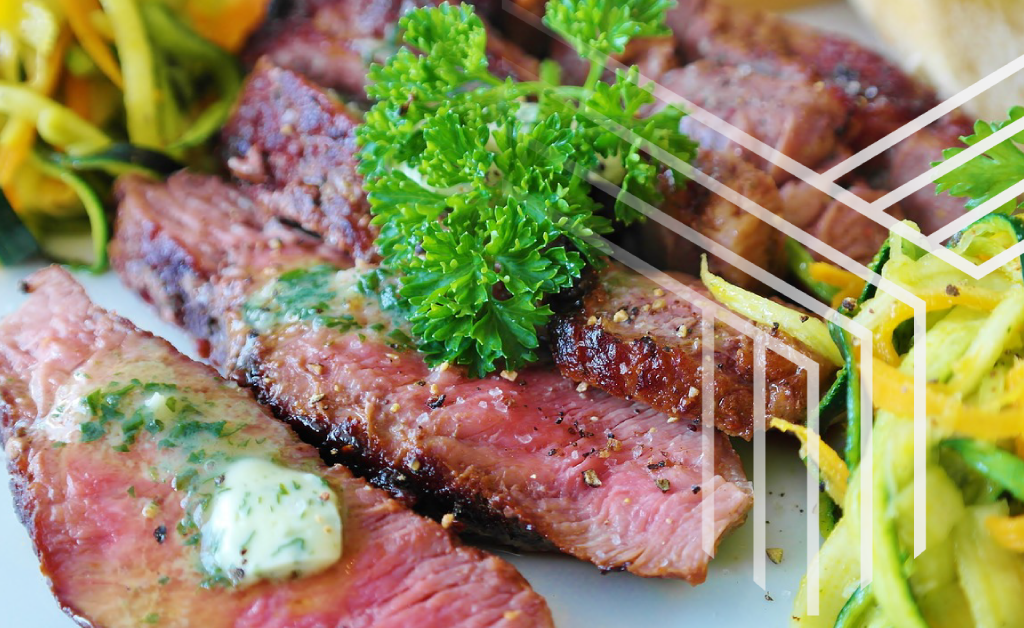When most people think of a protein-rich meal, beef steak may be the first to come to mind. This is the quintessential protein source to help build muscle, second only perhaps to chicken breasts. Not only that, but depending on the cut it can also be extremely flavourful and rich in other nutrients such as fat and iron. While there has been much debate over the healthiness of red meat in general, when eaten in moderation and as part of a balanced diet, beef steak can be an excellent treat that’s also dense in important nutrients to compliment muscle-building exercise.
If you’re unsure about the difference between types of steak, how they taste or if they’re good for you, then here is some nutrition advice on 10 different cuts of beef often classed as ‘steak’.
Nutrition Advice for Cuts of Beef Steak
1. Sirloin (Strip Steak)

Avg. Weight: 214g
7/10 tenderness
One of the most famous and well-known cuts, sirloin balances fat and protein well and is excellent either pan-fried or oven-roasted.
Per 100g
- 211kcal
- 10.6g fat
- 27.1g protein
2. Ribeye

Avg. Weight: 291g
8/10 tenderness
Many people consider this the ‘king of steak’. Ribeye’s high fat content makes it tender, juicy and flavourful. Perfect for roasting or frying.
Per 100g
- 291kcal
- 21.8g fat
- 23.7g protein
3. Fillet

Avg. Weight: 225g
9/10 tenderness
If ribeye is the ‘king’ then fillet is the ‘Rolls-Royce’. One of the most tender cuts, what fillet lacks in flavour it makes up for in protein. Cuts like butter when pan-fried rare. Works well with flavoured butters or sauces.
Per 100g
- 218kcal
- 11.1g fat
- 27.6g protein
4. Bottom Sirloin (Tri-tip)

Avg. Weight: 261g
6/10 tenderness
Quite low in fat, tender and affordable. Common in American grill restaurants, this cut is ideal for a protein-rich mid-week dinner.
Per 100g
- 211kcal
- 11.1g fat
- 26g protein
5. Top Sirloin

Avg. Weight: 306g
7/10 tenderness
Another sirloin cut, this has a rich flavour and good marbling of fat. Ideal for pan-frying.
Per 100g
- 243kcal
- 14.2g fat
- 27g protein
6. Topside

Avg. Weight: 236g
4/10 tenderness
High in protein but very lean, this cut requires slow cooking to help loosen its tough texture. This makes it perfect for stewing, braising or roasting in the oven with a sauce or vegetables.
Per 100g
- 192kcal
- 7.1g fat
- 27.5g protein
7. Flank

Avg. Weight: 383g
5/10 tenderness
A very thin, fibrous cut that benefits from slow-cooking, but also works well flash-fried rare or medium-rare if you don’t mind a tougher chew. Very flavourful and protein-rich.
Per 100g
- 192kcal
- 8.2g fat
- 27.7g protein
8. Skirt

Avg. Weight: 460g
3/10 tenderness
Similar toughness to flank and also very flavourful. Can be fried medium or stewed. Often very cheap to buy, so be sure to get some from your butcher for a tasty, affordable steak dinner.
Per 100g
- 220kcal
- 12.1g fat
- 26.1g protein
9. T-Bone/Porterhouse

Avg. Weight: 600g
8/10 tenderness
One of the most show-stopping steak cuts, you should definitely make this a rare treat. Combines a fillet and sirloin steak, joined by a bone that adds even more flavour when roasted. Juicy but with a very high fat content. Porterhouse is the larger variety.
Per 100g
- 247kcal
- 15.9g fat
- 24.2g protein
10. Tomahawk

Avg. Weight: 1kg
8/10 tenderness
Another whopper of a steak, this cut is one of the largest available and is essentially a large ribeye with the bone still attached. This makes it high in both fat and flavour, but requires a lot of cooking as it is very thick. It works perfectly when hard-fried on the outside then roasted like a joint of beef. Will comfortably feed 2-3 people.
Per 100g
- 291kcal
- 21.8g fat
- 23.7g protein
As you can see, there are many different cuts of beef, each with their own flavour, tenderness and nutritional values (and we haven’t even covered them all!). Simply calling them all ‘steak’ is almost too general, as depending on the cut, you can make completely different meals whether you flash-fry, slow cook or prepare them in any other way.
The important thing to remember is that while beef steaks are delicious and packed with protein and fat, they should always be eaten in moderation and as part of a well-balanced, healthy diet.
As a CEO, the best way to know what you should be eating to compliment good exercise and feel energised and productive is to train with CEO Personal Training. Not only will we design a tailored nutrition plan that effectively helps you build muscle and lose body fat while progressing in exercise, but we will design your programme based around your busy daily schedule, so you can be sure that you’ll always find the time to train and eat the right way.

